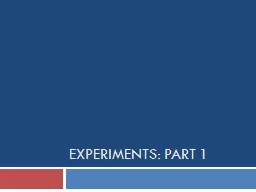

Overview How do experiments differ from observational studies What are the three main variables we need to consider in experimental research What are the similarities and differences between betweengroup and withinsubject experiments ID: 591739
Download Presentation The PPT/PDF document "Experiments: Part 1" is the property of its rightful owner. Permission is granted to download and print the materials on this web site for personal, non-commercial use only, and to display it on your personal computer provided you do not modify the materials and that you retain all copyright notices contained in the materials. By downloading content from our website, you accept the terms of this agreement.
Slide1
Experiments: Part 1Slide2
Overview
How do experiments differ from observational studies?
What are the three main variables we need to consider in experimental research?
What are the similarities and differences between between-group and within-subject experiments?Slide3
Background on Experiments
Study where a researcher systematically manipulates one variable in order to examine its effect(s) on one or more other variables
Two components
(2
nd
-most important point of this course)
Includes two or more groups
Participants are randomly assigned by the researcher
Random = Equal odds of being in any particular group
Examples
People
with GAD randomly assigned to three treatments so the researchers can examine which one best reduces
anxiety
Students
assigned to a “mortality salience” or control condition so the research can examine the impact on “war support”Slide4
Variables
I
ndependent Variable
Manipulated by the researcher
Typically categorical
Also called a “factor” that has “levels”
Factor = Type of anxiety treatmentLevel = CBT (or Psychodynamic or Control)Dependent VariableOutcome variable that is presumably influenced by (depends on the effects of) the independent variableBehavior frequencies, mood, attitudes, symptomsTypically continuousSlide5
Variables
Confounds (extraneous variables, 3
rd
variables)
Happens when unwanted differences (age, gender, researchers, environments, etc.) across experimental conditions
Plan: Think of potential confounds up front
Control for them methodologicallyMeasure them to examine whether they have an effectControl for them statisticallySlide6
Experimental Designs
Two basic designs
Between-group design
Also called a “between-subjects design,” or “randomized controlled trial” (if clinically focused)
Within-subject design
Also called a “repeated-measures design”Slide7
Between-group Design
IV: Type of group
Randomization: Different people randomized to different groups
DV: Usually a continuous
variableSlide8
Within-subject Design
IV: Type of group
Randomization: Each participant goes through more than one group, with order randomly assigned
DV: Usually a continuous variable, assessed repeatedly over time
Example: Participants go through more than one experimental conditionSlide9
Similarities
Uses the same type of analyses
p
-values obtained from
t
-tests (if two conditions) or
F-tests/ANOVA (if more than two conditions)Is the result statistically significant, reliable, trustworthy?Cohen’s d used to compute effect sizeTells the number of standard deviations by which two groups differ (kind of like r but on a scale from -∞ to
∞
)
Effect
r
r
2
d
Small
≥ .1
≥ .01
≥ 0.2
Medium
≥ .3
≥ .09
≥ 0.5
Large
≥ .5
≥ .25
≥ 0.8Slide10
Cohen’s
d
Calculator
http://
www.psychmike.com/calculators.php
Usually use the first formula, requires
M, SD, and nCan calculate by hand with a simple formula, but it doesn’t account for differences in sample size across conditions, so less accurated = = (Mean difference) / standard deviation
s
= average standard deviation across groupsSlide11
Calculation Example: Does
athletic involvement improve physical health
?
M
1
= 6.47
M2 = 6.75s = (1.87+1.94) / 2 = 1.91 d = (6.47 – 6.75) / 1.91 = -0.28 / 1.91 = -0.15 = 0.15
weak effect!
+/- sign is arbitrary, so
usually just droppedSlide12
2014 article in
Lancet
(impact factor: 45.2)
Take-home from the abstract:Slide13Slide14
Differences
Between-group design required when it is impossible or impractical to put participants through more than one condition
Within-subject design is more powerful
More likely to get significant
p
-value and bigger effect sizes. Why? It allows each participant to serve as their own control, canceling out a lot of cross-participant variability
Between-group design requires more peopleWithin-subject design is prone to ordering effects (order of conditions can effect results), such as progressive effects, or carryover effectsSolution: Counterbalancing